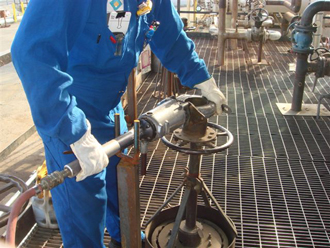IntroductionSafety legislation is safety law. Safety regulations are rules that tell people how to do things and how to behave. Health and Safety legislation, applies to schools as well as to industry. The law requires schools to ensure a safe working environment for everyone on the school premises. That includes visitors and trades people as well as staff and students. Teachers who are responsible for students in workshops, laboratories and other practical areas have a particular responsibility for ensuring the safety of everyone using their area. Designer’s Safety ResponsibilitySafety is fundamental to the design of products, systems and environments. A designer’s decisions will greatly affect the risks faced by the manufacturers and users of products, systems and environments. A competent designer will know what the potential hazards will be during construction, use, maintenance, cleaning and dismantling of a product and how to eliminate the hazards. Designers need to consider the conditions where the product will be used and the people who will use it. The designer’s duties are to eliminate hazards where feasible and where hazards cannot be eliminated, to reduce the risks as far as is reasonably practicable and to provide information about any remaining risks to health and safety. |
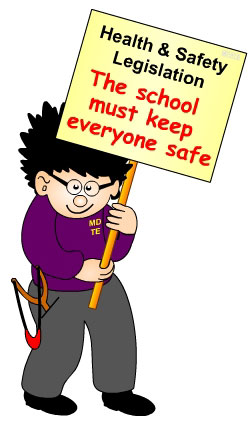 |
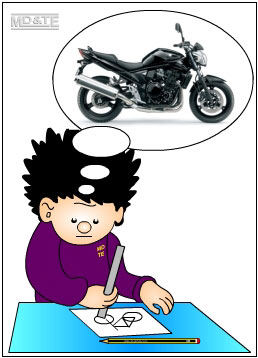 |
Students' Safety ResponsibilityWhen students incorporate safety into their design and technology work, they should be:
2. Students' safety responsibility - staying safeStudents must obey safety rules and respond appropriately to safety signs and floor markings. Students have a responsibility to use tools and equipment safely and effectively and to ensure that their actions do not endanger themselves or others. Students’ should identify hazardous situations, report it to the D&T teacher and/or technician and where appropriate, take action to eliminate hazards if possible and minimize any remaining risks to health and safety. |
Personal Protective Equipment (PPE)Personal protective equipment is required to protect people working in dirty or hazardous environments. The type of personal protective equipment required depends on the work being carried out. The photograph opposite shows a worker on an oil rig wearing overalls and gloves. The worker also wears safety shoes but they are not shown in this photograph. Personal protective equipment for students includes:
|
|
Examples of situations where personal protective equipment is required includes:
| Typical Activities | Personal Protective Equipment |
| Working at a bench using hand tools to measure, mark out, cut and shape metals wood and plastics, no dust or flying debris. | Apron, lab coat or overalls, safety shoes. |
| Working at a bench using hand tools to cut and shape metals wood and plastics, with dust and flying debris. | Apron, lab coat or overalls, face mask, safety glasses, safety shoes. |
| Using machines, pedestal drill, lathe, milling machine, etc. | Apron, lab coat or overalls, safety glasses or visor, safety shoes. |
| Abrading metal, wood and plastic. | Apron, lab coat or overalls, safety glasses or visor, face mask, safety shoes. |
| Soldering and brazing | Apron, lab coat or overalls, safety glasses or visor, leather gauntlets, safety shoes. |
| Gas welding | Leather apron, apron, lab coat or overalls, gas welding glasses/goggles, leather gauntlets, safety shoes. |
| Electric arc welding | Leather apron, lab coat or overalls, electric arc welding shield, leather gauntlets, safety shoes. |
| Heat treatment of metals | Leather apron, apron, lab coat or overalls, safety glasses or visor, leather gauntlets, safety shoes. |
| Foundry work / metal casting | Leather apron, leather spats over safety shoes or shoes made especially for metal casting, face mask, visor, (with wire mesh if available), leather gauntlets. |
| Plastic forming using a strip heater, vacuum former | Apron, lab coat or overalls, safety shoes, leather gloves, safety glasses, goggles or visor. |
| Plastic polishing - using a buffer | Apron, lab coat or overalls, safety shoes, safety glasses, goggles or visor, face mask. |
| Resin casting / hand lay-up of GRP | Apron, lab coat or overalls, safety shoes, disposable plastic gloves, safety glasses, face mask. |
| Using acrylic cements | Apron, lab coat or overalls, safety glasses, goggles or visor, face mask, disposable plastic gloves. |
| Etching and pickling | Apron, lab coat or overalls, safety glasses, goggles or visor, face mask, disposable plastic gloves, safety shoes. |
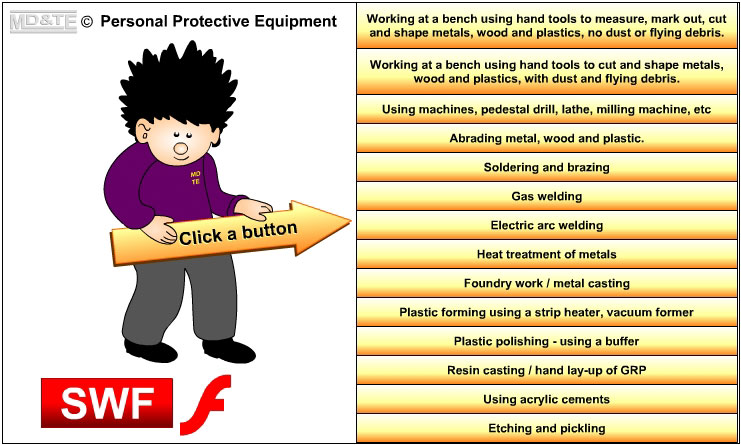
Click on the screenshot above to view the "Personal Protective Equipment" animation by Laszlo Lipot
An image showing the Flash animation logo Flash animations are embedded into the pages of all my D&T Modules but there are pictorial links to the animations on this web site so that devices that cannot play Flash animations will at least show a jpeg screenshot of the animation. If your PC or personal digital assistant (PDA) can play Flash animations you may click on an image showing the Flash animation logo |
Risk Assessment
Anything that can cause an accident is a hazard. A risk is the likelihood of a misfortune occurring caused by a hazard.
Carrying out practical work in design and technology is hazardous and we should protect ourselves and other people by taking actions to remove or minimise the risks to our health and safety. To make a risk assessment we should:
- decide the nature of the hazard;
- estimate the likelihood of an accident happening;
- estimate how serious such an accident would be;
- judge the acceptability of using the process, technique or substance;
- accept the risk or alter the procedure;
- record the assessment.
A risk assessment may be a written assessment of hazardous activities and situations, or it may be set out in a table, as shown below. The assessment of the risk to people's health and safety may be shown as a high, medium or low risk, or the level of risk may be given a number, e.g. 1 to 5 with 1 being a low risk and 5 being a high risk.
Risk Assessment |
|||
Hazardous Activity / Situation |
Risk |
Assessment |
Action / Control Measure |
| Drilling a Ø4 mm hole in 6mm thick steel. | Getting clothes caught in revolving drill chuck. | high risk |
Tuck tie in shirt, roll up sleeves, wear protective apron/lab. coat. |
| Getting long hair caught in revolving drill chuck. | high risk |
Tie back long hair. | |
| Drill bit getting stuck in work and the work spinning. | high risk |
Clamp material being drilled to the drill table. | |
| Leaving a chuck key in a chuck. | Chuck key flying out of chuck when the machine is switched on. | high risk |
Never leave a chuck key in a chuck. If available, use a spring loaded chuck key that will not stay in a chuck unless held there. |
| Chuck key is fixed to a drilling machine by a length of chain. | Leaving chuck key in a chuck. The machine being started when a student is still tightening the chuck, the chain wraps around the student's fingers and .... | high risk |
Never fix a chuck key to a machine by a chain or any other means. |
Risk assessments should be recorded at the design and planning stage of any design and technology work. Safety Officers responsible for carrying out risk assessments in schools and industry should also:
- ensure that everyone knows what the risk assessment says;
- ensure that recommended actions to reduce or eliminate the risks are carried out;
- ensure that everyone knows what to do if an accident occurs.
Click here to go to Risk Assessment Exercises
For further information:
- Look at the Health and Safety Executives "Five Steps To Risk Assessment" at http://www.hse.gov.uk/pubns/indg163.pdf
- Fun look at health and safety at http://www.risk-ed.org/pages/hazard_frameset.htm
- Use CLEAPSS, Model Risk Assessments for Design and Technology in Secondary Schools and Colleges to check the risks involved with using various D&T tools, processes and materials.
Safety Rules and Defined Procedures
Safety rules are defined procedures, i.e. safety rules tell students how they must behave and how they must do things.
Defined procedures are intended to prevent accidents, e.g. before using a drilling machine, you must:
- check that the drill is tight in the chuck
- check that the chuck key is not left in the chuck
- check the speed setting of the drilling machine
- check that guards are in place
- roll up your sleeves
- remove rings and anything else that could get caught in the revolving chuck
- tuck your tie into your shirt
- wear goggles or a visor
- make sure that the material to be drilled is held firmly and safely, preferably clamped to the drill table
- never wear gloves or hold the material being drilled with a rag as it may get caught in the revolving chuck and very, very seriously damage your fingers.
Defined procedures reduce or eliminate risks if people know the defined procedures for hazardous situations and proceed as defined. In other words, safety rules work when people know the safety rules and obey them. School workshop safety rules are designed to ensure the Health and Safety of people in the school workshop environment. Examples of defined procedures in response to risk assessments may be seen in the workshop safety rules and CLEAPSS, Model Risk Assessments for Design and Technology in Secondary Schools and Colleges.
Hazard Warnings and Instructions
Hazard warnings and instructions can be given using words, pictures, lights, floor markings and other signals. Some typical workshop safety signs are shown below.
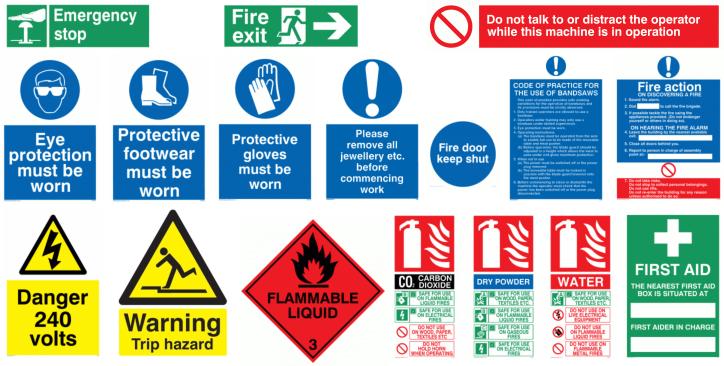
Click here to go to the hazard warning and safety signs exercises.
Click here to go to safety signs flash cards
Safe Materials
Materials should be safe for students to use for their design and technology activities; however, some materials such as etching solutions are hazardous. Those that are hazardous but have an acceptable level of risk, should be used in a safe manner in accordance with defined procedures.
A material such as aluminium may become hazardous as it is processed, e.g. when it is melted and the molten metal is poured or when thin sheet aluminium is cut with tinsnips. Materials may also become hazardous when the finished product is used e.g. by poisoning or by suffocation.
Students should refer to CLEAPSS Model Risk Assessments for Design and Technology in Secondary Schools and Colleges for more information.
Safe Storage of MaterialsMaterials should be stored so that:
Safe Storage of ToolsTools should be stored so that:
|
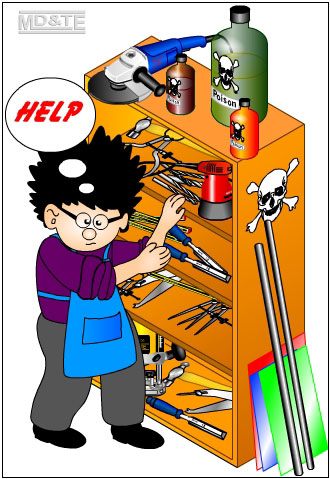 |
Tool Safety
A tool is safe to use when:
- its design has no inherent faults
- it is well maintained
- it is controlled in a competent manner
- it is used for its intended purpose.
Design and technology hand tools and machine tools are designed to cut, to abrade, to polish, to heat etc, so have parts that pose a risk to students' health and safety. The moving parts of machine tools are wherever practicable shielded by guards, some of which incorporate micro switches that switch the machine off when the guard is opened or removed. However some moving parts of machinery are exposed out of necessity, so the operator must be competent to use the machine, must be strong enough to control the machine and must wear the recommended personal protective equipment (PPE) such as goggles.
Electric cables on power tools are particularly prone to damage and should be checked before the tool is used.
Safety Features on Tools
Safety features on tools help prevent people from being cut by the tool, being caught in the moving parts of machine tools, from being injured by debris flying from machined material and from being injured by electric shock. Safety features include guards, dust and fume extraction devices and residual current devices (RCD) circuit breakers and key locked isolator switches.
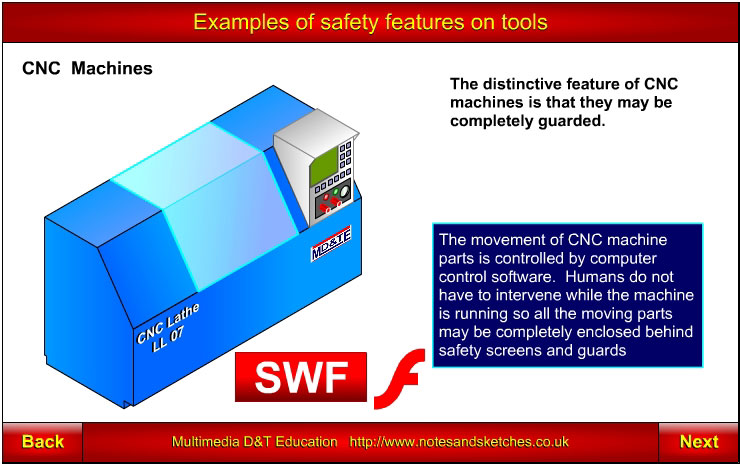
Safe Working PracticesSafe working practices include:
Tools should always be used in accordance with manufacturers’ instructions. The manufacturers’ instructions should identify the tool's limitations and how it should be used safely. (See product safety below) |
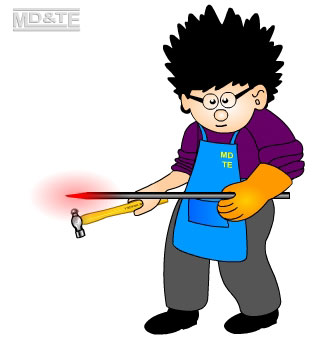 |
Safe Working Area
A safe working area can be created by:
- students and other users of the area behaving in a responsible manner
- allowing sufficient space for work to be carried out unhindered
- allowing movement to be carried out unhindered
- keeping coats and bags in a designated area at the edge of the workshop
- making sure that there is minimum movement to fetch and carry tools and materials,
- removing or tidying away clutter
- reducing noise to a minimum
- ensuring good ventilation
- ensuring good lighting conditions
- ensuring that hazardous materials are stored properly and securely and used with the aid of appropriate safety equipment
- ensuring that fixed machine tools are properly bolted down in designated positions
- ensuring that moving parts on machinery are fitted with appropriate guards and that these guards are properly adjusted for the purpose for which the machine is being used
- ensuring that personal protective equipment is available and stored in appropriate locations
- ensuring that fume cupboards, welding arc screens and other appropriate safety devices match the requirements of the processes being carried out and are available.
Product Safety
The health and safety requirements of the end users should be considered when designing and making products. Products designed and made in design and technology lessons should be safe for people to use. Any product manufactured in the United Kingdom that will be sold in the UK or abroad, comes under "The General Product Safety Regulations 2005".
A PDF copy of the regulations may be downloaded from http://www.legislation.gov.uk/uksi/2005/1803/pdfs/uksi_20051803_en.pdf
Part 2 of the General Product Safety Regulations 2005, states:
General safety requirement
5.—(1) No producer shall place a product on the market unless the product is a safe product.
(2) No producer shall offer or agree to place a product on the market or expose or possess a
product for placing on the market unless the product is a safe product.
(3) No producer shall offer or agree to supply a product or expose or possess a product for
supply unless the product is a safe product.
(4) No producer shall supply a product unless the product is a safe product.Other obligations of producers
7.—(1) Within the limits of his activities, a producer shall provide consumers with the relevant
information to enable them—
(a) to assess the risks inherent in a product throughout the normal or reasonably foreseeable
period of its use, where such risks are not immediately obvious without adequate
warnings, and
(b) to take precautions against those risks.
(2) The presence of warnings does not exempt any person from compliance with the other
requirements of these Regulations.
(3) Within the limits of his activities, a producer shall adopt measures commensurate with the
characteristics of the products which he supplies to enable him to—
(a) be informed of the risks which the products might pose, and
(b) take appropriate action including, where necessary to avoid such risks, withdrawal,
adequately and effectively warning consumers as to the risks or, as a last resort, recall.
(4) The measures referred to in paragraph (3) include—
(a) except where it is not reasonable to do so, an indication by means of the product or its
packaging of—
(i) the name and address of the producer, and
(ii) the product reference or where applicable the batch of products to which it belongs;
and
(b) where and to the extent that it is reasonable to do so—
(i) sample testing of marketed products,
(ii) investigating and if necessary keeping a register of complaints concerning the safety
of the product, and
(iii) keeping distributors informed of the results of such monitoring where a product
presents a risk or may present a risk.
Product safety summary
Product designers and manufacturers must not sell unsafe products. Product designers and manufacturers must provide information about any risks to health and safety posed by their product, take action to minimise the risks and if necessary, withdraw the product from the market. Products should be safe to touch, safe to taste, safe to view, safe to listen to and should be electrically, mechanically and ergonomically safe. Products should be issued with guidance about how to use the product safely and information about the limitations of the product.
Other obligations include supplying the name and address of the manufacturer and where appropriate, a product reference or information about the batch of products to which the product belongs.
Samsung and other manufacturers provide PDF copies of their product handbooks and instruction manuals. These handbooks contain safety information about the product and user instructions. Samsung product handbooks and instruction manuals may be downloaded from their web site at http://www.samsung.com/uk/support/download/supportDownloadMain.do .
| Click here to view the PDF version of this resource. | 
|
 |
